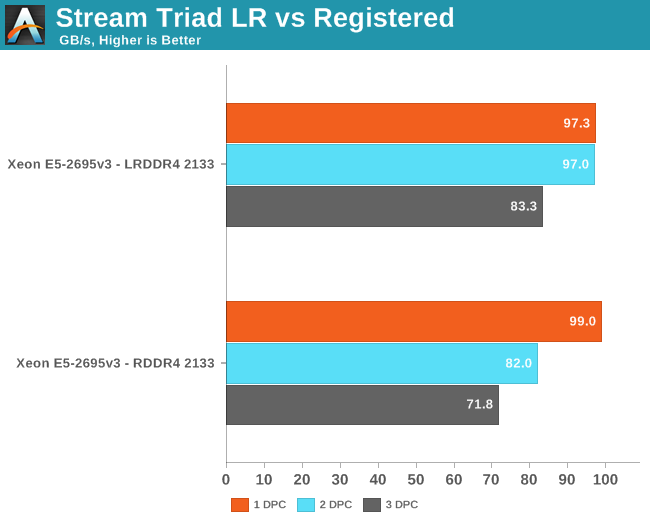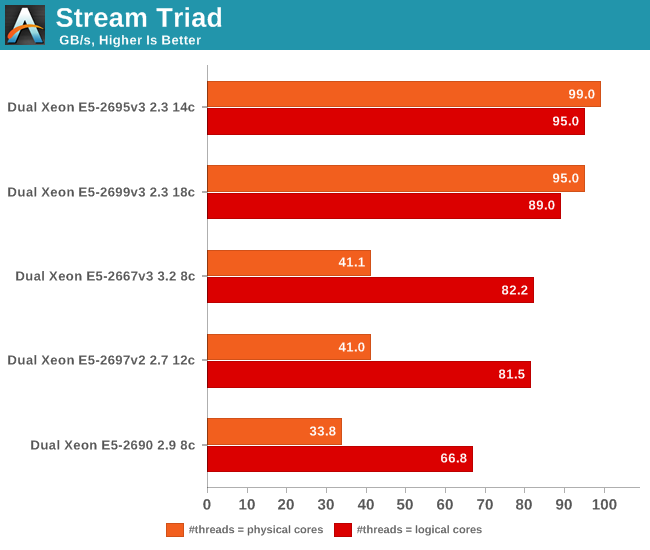Intel Xeon E5 Version 3: Up to 18 Haswell EP Cores
by Johan De Gelas on September 8, 2014 12:30 PM ESTMemory Subsystem Bandwidth
Let's set the stage first and perform some meaningful low level benchmarks. First, we measured the memory bandwidth in Linux. The binary was compiled with the Open64 compiler 5.0 (Opencc). It is a multi-threaded, OpenMP based, 64-bit binary. The following compiler switches were used:
-Ofast -mp -ipa
The results are expressed in GB per second. Note that we also tested with gcc 4.8.1 and compiler options
-O3 –fopenmp –static
Results were consistently 20% to 30% lower with gcc, so we feel our choice of Open64 is appropriate. Everybody can reproduce our results (Open64 is freely available) and since the binary is capable of reaching higher speeds, it is easier to spot speed differences. First we compared our DDR4-2133 LRDIMMs with the Registered DDR4-2133 DIMMs on the Xeon E5-2695 v3 (14 cores at 2.3GHz, Turbo up to 3.6GHz).

Registered DIMMs are slightly faster at 1DPC, but LRDIMMs are clearly faster when you insert more than one DIMM per channel. We measured a 16% to 18% difference in performance. It's interesting to note that LRDIMMs are supposed to run at 1600 at 3DPC according to Intel's documentation, but our bandwidth measurement points to 1866. The command "dmidecode -type 17" that reads out the BIOS confirmed this.
Next, we compared the different Xeon platforms.

The new Xeon E5-2600 v3 has access to 15-21% more bandwidth than the E5-2600 v2, which uses DDR3-1866, and almost 50% more than the first Xeon E5s (DDR3-1600). Interestingly, the previous generation Xeons and the Xeon E5-2667 v3 need to use one thread per logical thread to use the full potential of the memory controller. The reason that the Xeon E5-2667 v3 shows similar behavior as the previous Xeons is that it is also a die with one dual ring and one memory controller. Also, 16 threads (one per physical core) is probably not enough to get the full potential of a quad channel DDR4-2133 memory subsystem. The new High Core Count (HCC, 14-18 core) Xeon E5 chips perform better with one thread per physical processor.
Although it makes sense that a CPU needs a certain number of threads to get its memory controller working at full speed, it's still interesting to note that the previous 12-core Xeon E5-2697 v2 can only offer 41GB/s at 24 threads while the 14-core Xeon E5-2695 v3 is already delivering more than twice as much bandwidth at 28 threads. Of course, those kind of bandwidth numbers only matter for specific HPC benchmarks as the L3 cache (30-45MB L3) will take care of most of the requests. Latency however always matters.










85 Comments
View All Comments
martinpw - Monday, September 8, 2014 - link
There is a nice tool called i7z (can google it). You need to run it as root to get the live CPU clock display.kepstin - Monday, September 8, 2014 - link
Most Linux distributions provide a tool called "turbostat" which prints statistical summaries of real clock speeds and c state usage on Intel cpus.kepstin - Monday, September 8, 2014 - link
Note that if turbostat is missing or too old (doesn't support your cpu), you can build it yourself pretty quick - grab the latest linux kernel source, cd to tools/power/x86/turbostat, and type 'make'. It'll build the tool in the current directory.julianb - Monday, September 8, 2014 - link
Finally the e5-xxx v3s have arrived. I too can't wait for the Cinebench and 3DS Max benchmark results.Any idea if now that they are out the e5-xxxx v2s will drop down in price?
Or Intel doesn't do that...
MrSpadge - Tuesday, September 9, 2014 - link
Correct, Intel does not really lower prices of older CPUs. They just gradually phase out.tromp - Monday, September 8, 2014 - link
As an additional test of the latency of the DRAM subsystem, could you please run the "make speedup" scaling benchmark of my Cuckoo Cycle proof-of-work system at https://github.com/tromp/cuckoo ?That will show if 72 threads (2 cpus with 18 hyperthreaded cores) suffice to saturate the DRAM subsystem with random accesses.
-John
Hulk - Monday, September 8, 2014 - link
I know this is not the workload these parts are designed for, but just for kicks I'd love to see some media encoding/video editing apps tested. Just to see what this thing can do with a well coded mainstream application. Or to see where the apps fades out core-wise.Assimilator87 - Monday, September 8, 2014 - link
Someone benchmark F@H bigadv on these, stat!iwod - Tuesday, September 9, 2014 - link
I am looking forward to 16 Core Native Die, 14nm Broadwell Next year, and DDR4 is matured with much better pricing.Brutalizer - Tuesday, September 9, 2014 - link
Yawn, the new upcoming SPARC M7 cpu has 32 cores. SPARC has had 16 cores for ages. Since some generations back, the SPARC cores are able to dedicate all resources to one thread if need be. This way the SPARC core can have one very strong thread, or massive throughput (many threads). The SPARC M7 cpu is 10 billion transistors:http://www.enterprisetech.com/2014/08/13/oracle-cr...
and it will be 3-4x faster than the current SPARC M6 (12 cores, 96 threads) which holds several world records today. The largest SPARC M7 server will have 32-sockets, 1024 cores, 64TB RAM and 8.192 threads. One SPARC M7 cpu will be as fast as an entire Sunfire 25K. :)
The largest Xeon E5 server will top out at 4-sockets probably. I think the Xeon E7 cpus top out at 8-socket servers. So, if you need massive RAM (more than 10TB) and massive performance, you need to venture into Unix server territory, such as SPARC or POWER. Only they have 32-socket servers capable of reaching the highest performance.
Of course, the SGI Altix/UV2000 servers have 10.000s of cores and 100TBs of RAM, but they are clusters, like a tiny supercomputer. Only doing HPC number crunching workloads. You will never find these large Linux clusters run SAP Enterprise workloads, there are no such SAP benchmarks, because clusters suck at non HPC workloads.
-Clusters are typically serving one user who picks which workload to run for the next days. All SGI benchmarks are HPC, not a single Enterprise benchmark exist for instance SAP or other Enterprise systems. They serve one user.
-Large SMP servers with as many as 32 sockets (or even 64-sockets!!!) are typically serving thousands of users, running Enterprise business workloads, such as SAP. They serve thousands of users.